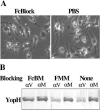Anti-LcrV antibody inhibits delivery of Yops by Yersinia pestis KIM5 by directly promoting phagocytosis
- PMID: 16113334
- PMCID: PMC1231128
- DOI: 10.1128/IAI.73.9.6127-6137.2005
Anti-LcrV antibody inhibits delivery of Yops by Yersinia pestis KIM5 by directly promoting phagocytosis
Abstract
LcrV of Yersinia pestis is a major protective antigen proposed for inclusion in subunit plague vaccines. One way that anti-LcrV antibody is thought to protect is by inhibiting the delivery of toxins called Yops to host cells. The present study characterizes the relation between this inhibition and the phagocytosis of the bacteria. J774A.1 cells were infected with Y. pestis KIM5 in the presence of a protective polyclonal anti-LcrV antibody or a nonprotective polyclonal anti-YopM antibody, and delivery of YopH and YopE into the cytoplasm was assayed by immunoblotting. The ability to inhibit the delivery of these Yops depended upon having antibody bound to the cell surface; blocking conditions that prevented the binding of antibody to Fc receptors prevented the inhibition of Yop delivery. Anti-LcrV antibody also promoted phagocytosis of the yersiniae, whereas F(ab')(2) fragments did not. Further, anti-LcrV antibody could not inhibit the delivery of Yops into cells that were unable to phagocytose due to the presence of cytochalasin D. However, Yops were produced only by extracellular yersiniae. We hypothesize that anti-LcrV antibody does not directly inhibit Yop delivery but instead causes phagocytosis, with consequent inhibition of Yop protein production in the intracellular yersiniae. The prophagocytic effect of anti-LcrV antibody extended to mouse polymorphonuclear neutrophils (PMNs) in vitro, and PMNs were shown to be critical for protection: when PMNs in mice were ablated, the mice lost all ability to be protected by anti-LcrV antibody.
Figures











Similar articles
-
Antibody against V antigen prevents Yop-dependent growth of Yersinia pestis.Infect Immun. 2005 Mar;73(3):1532-42. doi: 10.1128/IAI.73.3.1532-1542.2005. Infect Immun. 2005. PMID: 15731051 Free PMC article.
-
Direct neutralization of type III effector translocation by the variable region of a monoclonal antibody to Yersinia pestis LcrV.Clin Vaccine Immunol. 2014 May;21(5):667-73. doi: 10.1128/CVI.00013-14. Epub 2014 Mar 5. Clin Vaccine Immunol. 2014. PMID: 24599533 Free PMC article.
-
Yersinia pestis can bypass protective antibodies to LcrV and activation with gamma interferon to survive and induce apoptosis in murine macrophages.Clin Vaccine Immunol. 2009 Oct;16(10):1457-66. doi: 10.1128/CVI.00172-09. Epub 2009 Aug 26. Clin Vaccine Immunol. 2009. PMID: 19710295 Free PMC article.
-
The Yersinia Yop virulon, a bacterial system to subvert cells of the primary host defense.Folia Microbiol (Praha). 1998;43(3):253-61. doi: 10.1007/BF02818610. Folia Microbiol (Praha). 1998. PMID: 9717252 Review.
-
Plague vaccines and the molecular basis of immunity against Yersinia pestis.Hum Vaccin. 2009 Dec;5(12):817-23. doi: 10.4161/hv.9866. Epub 2009 Dec 1. Hum Vaccin. 2009. PMID: 19786842 Review.
Cited by
-
Antibiotic Therapy of Plague: A Review.Biomolecules. 2021 May 12;11(5):724. doi: 10.3390/biom11050724. Biomolecules. 2021. PMID: 34065940 Free PMC article. Review.
-
Antibodies and cytokines independently protect against pneumonic plague.Vaccine. 2008 Dec 9;26(52):6901-7. doi: 10.1016/j.vaccine.2008.09.063. Epub 2008 Oct 14. Vaccine. 2008. PMID: 18926869 Free PMC article.
-
Induction of Type I Interferon through a Noncanonical Toll-Like Receptor 7 Pathway during Yersinia pestis Infection.Infect Immun. 2017 Oct 18;85(11):e00570-17. doi: 10.1128/IAI.00570-17. Print 2017 Nov. Infect Immun. 2017. PMID: 28847850 Free PMC article.
-
Molecular Targets and Strategies for Inhibition of the Bacterial Type III Secretion System (T3SS); Inhibitors Directly Binding to T3SS Components.Biomolecules. 2021 Feb 19;11(2):316. doi: 10.3390/biom11020316. Biomolecules. 2021. PMID: 33669653 Free PMC article. Review.
-
B cells and antibodies in the defense against Mycobacterium tuberculosis infection.Immunol Rev. 2015 Mar;264(1):167-81. doi: 10.1111/imr.12276. Immunol Rev. 2015. PMID: 25703559 Free PMC article. Review.
References
-
- Cormack, B. P., R. H. Valdivia, and S. Falkow. 1996. FACS-optimized mutants of the green fluorescent protein (GFP). Gene 173:33-38. - PubMed
Publication types
MeSH terms
Substances
Grants and funding
LinkOut - more resources
Full Text Sources
Other Literature Sources
Medical

